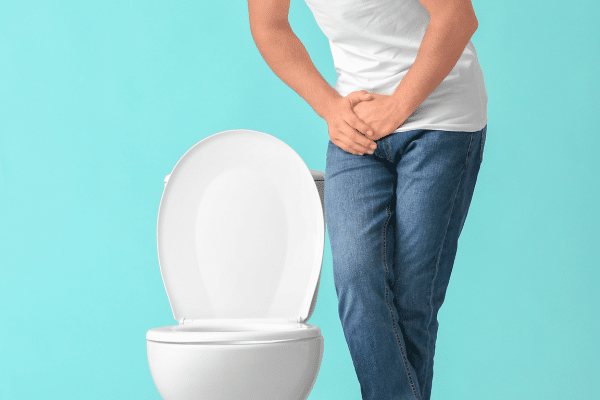If you live with sudden urgency, frequent bathroom trips, or leaks, you are not alone. Many people quietly wonder what is overactive bladder and whether anything can help. This guide explains the condition in clear terms and offers practical next steps. You will find causes, testing, and therapies you can discuss with your clinician.
Key Takeaways
- Clear definition: OAB means urgency, often with frequency and nighttime trips.
- Multiple causes: bladder signaling, hormones, nerves, or other conditions.
- Stepwise care: habits and pelvic floor first, then medicines or procedures.
- Personalized plan: women, men, and younger adults may need tailored choices.
What Is Overactive Bladder
Overactive bladder (OAB) is a symptom-based condition marked by sudden, hard-to-delay urges to urinate. People may also pass urine often during the day, wake at night (nocturia), and sometimes leak with urgency (urge incontinence). Clinicians often describe detrusor overactivity (bladder muscle overactivity), which can drive these sensations. Not everyone has all features; urgency is the core symptom.
OAB is common, but it is not a normal part of aging. It can affect work, intimacy, sleep, and mood. Thankfully, several approaches can help you regain control. For a clinical overview aligned with expert consensus, see the NIDDK overview from the U.S. National Institute of Diabetes and Digestive and Kidney Diseases.
Recognising Symptoms and When to Seek Care
People describe urgent, difficult-to-delay needs to void, sometimes followed by leaks. Many notice going more than eight times daily or waking multiple times overnight. These patterns align with overactive bladder symptoms and often fluctuate with fluid intake, stress, or caffeine. When symptoms disrupt sleep or social life, a clinical visit can help clarify causes and options.
Track your bladder habits for three days before the visit. A simple diary can capture timing, volumes, leaks, and triggers like coffee, tea, or carbonated drinks. Bring any incontinence pads you use; they can help estimate severity. If you also have burning, fever, blood in urine, or pelvic pain, seek prompt evaluation to rule out infection or stones.
Why It Happens: Causes and Risk Factors
OAB has many possible drivers. The bladder muscle can contract too often, or nerves can misread fullness signals. Constipation, pelvic floor weakness, menopause-related changes, an enlarged prostate, or neurologic conditions may contribute. Certain drugs, such as diuretics or some antidepressants, can aggravate urgency.
Hormonal shifts, childbirth, and pelvic surgery may alter support structures, especially in women. Understanding what causes overactive bladder in females can guide targeted therapy, including pelvic floor work and topical estrogen where appropriate. For evidence-based context on mechanisms and care sequences, the AUA guideline from the American Urological Association offers a conservative, stepwise approach.
How Doctors Diagnose OAB
Diagnosis starts with a careful history and physical exam. Your clinician may review a bladder diary, check for constipation, and assess pelvic floor tone. Basic tests often include urinalysis to rule out infection and a post-void residual to ensure proper bladder emptying. Many people do not need invasive testing during the first evaluation.
Sometimes, additional studies help when symptoms are complex or treatments have not worked. These may include urodynamics to assess bladder pressures, cystoscopy to inspect the bladder lining, or imaging if stones or blockage are suspected. The goal is to match treatment to your pattern of symptoms, not just a number on a test.
First-Line Care: Habits and Pelvic Floor Training
Foundational care focuses on small, repeatable behaviors. Timed voiding, fluid pacing, and cutting back on bladder irritants can reduce urgency. Many people benefit from pelvic floor muscle training (Kegels) with biofeedback, which helps coordinate muscles during urgency episodes. These steps can support progress before moving to prescriptions.
Simple steps count as overactive bladder home remedies when used thoughtfully. Try a two-week trial of caffeine reduction, evening fluid limits, and bladder training with a diary to track progress. A continence therapist can tailor exercises and coach through setbacks. If constipation worsens urgency, treat it in parallel to avoid mixed signals to the bladder.
Medications and Other Treatments
When symptoms persist, clinicians may suggest prescription options, devices, or minimally invasive procedures. Medication choices target the bladder muscle or the nerves that regulate it. Your plan may combine behavior strategies with drugs for the best balance of relief and tolerability. This stepwise approach reflects guideline-based overactive bladder treatment.
Two prescription groups are most common. Antimuscarinics (muscarinic blockers) help calm muscle contractions. Beta-3 adrenergic agonists (bladder muscle relaxers) help the bladder store more comfortably. In refractory cases, options such as tibial nerve stimulation, sacral neuromodulation, or onabotulinumtoxinA injections may be considered after discussion with a specialist.
Tip: Ask about likely benefits, common side effects, and how progress will be measured over 4–8 weeks. A shared plan can reduce trial-and-error frustration.
Antimuscarinics include several familiar agents. For example, discuss Oxybutynin if you want to compare tablet and patch formats; the patch may change how side effects present. You can also review Vesicare and Solifenacin Succinate to understand once-daily dosing options and food considerations.
Choosing a Medicine: Benefits and Side Effects
Picking a drug is personal. Your clinician will balance dryness of mouth, constipation, and potential cognitive risks against symptom gains. Those who prefer a different mechanism can consider a beta-3 agonist like mirabegron; see Myrbetriq to learn how a non-anticholinergic option may fit your plan. For an overview of titration and schedules, this internal guide on Myrbetriq Dosing Explained can support clinic discussions.
Some people explore specific antimuscarinics that suit daily routines. Extended-release options like Tolterodine LA may help reduce peaks and troughs; those details matter for steady symptom days. You can compare with Toviaz if you want to review related agents in the same class. When considering brand and generic choices together, a quick look at Myrbetriq vs Oxybutynin explains how mechanisms differ and why one might suit you.
Your clinician may also discuss classic immediate-release tolterodine; the brand reference page Tolterodine outlines tablet strengths for context. If you are comparing side effect profiles before trying a beta-3 option, the editorial on Common and Serious Myrbetriq Side Effects highlights what many patients monitor at home. For prescribing information on mirabegron safety, the FDA label provides authoritative details that clinicians rely on.
People often ask whether a single best option exists. There is no universal overactive bladder medication, but matching your symptoms, other conditions, and side effect tolerance can narrow choices. Shared decision-making and short, planned trials reduce frustration and improve comfort.
Care by Population: Women, Men, Younger Adults
Life stage and sex can shape symptoms and choices. In midlife and beyond, estrogen decline may change bladder and urethral tissues. Pelvic floor therapy and topical treatments may help in selected cases. When appropriate, overactive bladder medication for women can be combined with continence training for stronger results.
Men may experience OAB with or without prostate enlargement. If blockage is suspected, clinicians may address both issues to protect bladder emptying. Younger adults can also be affected, including those in their 20s with athletic routines or high caffeine intake. In each group, tailor goals to daily demands, such as uninterrupted classes, safe commutes, or caregiving.
Living With OAB: Duration and Outlook
Many people want to know how symptoms evolve over time. In real life, flares and calm periods alternate. Some notice seasonal or stress-related changes. Asking how long does overactive bladder last makes sense, yet there is no single timeline. What matters is building skills and supports you can keep using.
Set small, trackable goals each month, such as one fewer nighttime trip. Adjust your plan if sleep or mood remains poor. A diary can reveal wins you might overlook. Over time, most people find a combination of habits and treatments that makes days more predictable and nights more restful.
Practical Tools for Daily Control
Small tools can make a real difference. Consider mapping bathroom locations on regular routes to lower anxiety. Keep a spare set of clothes or pads in your bag during early treatment weeks. Use phone reminders for timed voids while bladder training.
Note: Comfort matters. Choose breathable underwear and moisture-wicking fabrics for long shifts or travel days. For topic-by-topic updates and related conditions, browse our Urology Posts to see how clinicians frame choices across bladder and prostate care.
Recap
OAB is common, disruptive, and manageable. You learned core definitions, symptom patterns, and why causes differ. We reviewed stepwise care, from habits and pelvic floor training to medications and procedures. We also covered how needs vary for women, men, and younger adults.
Bring a diary, your goals, and questions to your next appointment. Ask about options that match your routine and side effect tolerance. Progress may be gradual, but every small gain supports better days and steadier nights.
This content is for informational purposes only and is not a substitute for professional medical advice.

